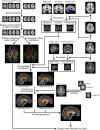Cholinergic white matter pathways in dementia with Lewy bodies and Alzheimer's disease
- PMID: 34605858
- PMCID: PMC9166545
- DOI: 10.1093/brain/awab372
Cholinergic white matter pathways in dementia with Lewy bodies and Alzheimer's disease
Abstract
Patients who have dementia with Lewy bodies and Alzheimer's disease show early degeneration of the cholinergic nucleus basalis of Meynert. However, how white matter projections between the nucleus basalis of Meynert and the cortex are altered in neurodegenerative disease is unknown. Tractography of white matter pathways originating from the nucleus basalis of Meynert was performed using diffusion-weighted imaging in 46 patients with Alzheimer's disease dementia, 48 with dementia with Lewy bodies, 35 with mild cognitive impairment with Alzheimer's disease, 38 with mild cognitive impairment with Lewy bodies and 71 control participants. Mean diffusivity of the resulting pathways was compared between groups and related to cognition, attention, functional EEG changes and dementia conversion in the mild cognitive impairment groups. We successfully tracked a medial and a lateral pathway from the nucleus basalis of Meynert. Mean diffusivity of the lateral pathway was higher in both dementia and mild cognitive impairment groups than controls (all P < 0.03). In the patient groups, increased mean diffusivity of this pathway was related to more impaired global cognition (β = -0.22, P = 0.06) and worse performance on an attention task (β = 0.30, P = 0.03). In patients with mild cognitive impairment, loss of integrity of both nucleus basalis of Meynert pathways was associated with increased risk of dementia progression [hazard ratio (95% confidence interval), medial pathway: 2.51 (1.24-5.09); lateral pathway: 2.54 (1.24-5.19)]. Nucleus basalis of Meynert volume was reduced in all clinical groups compared to controls (all P < 0.001), but contributed less strongly to cognitive impairment and was not associated with attention or dementia conversion. EEG slowing in the patient groups as assessed by a decrease in dominant frequency was associated with smaller nucleus basalis of Meynert volumes (β = 0.22, P = 0.02) and increased mean diffusivity of the lateral pathway (β = -0.47, P = 0.003). We show that degeneration of the cholinergic nucleus basalis of Meynert in Alzheimer's disease and dementia with Lewy bodies is accompanied by an early reduction in integrity of white matter projections that originate from this structure. This is more strongly associated with cognition and attention than the volume of the nucleus basalis of Meynert itself and might be an early indicator of increased risk of dementia conversion in people with mild cognitive impairment.
Keywords: basal forebrain; diffusion-weighted imaging; mild cognitive impairment; nucleus basalis of Meynert; probabilistic tractography.
© The Author(s) (2021). Published by Oxford University Press on behalf of the Guarantors of Brain.
Figures





References
-
- Gratwicke J, Kahan J, Zrinzo L, et al. . The nucleus basalis of Meynert: A new target for deep brain stimulation in dementia? Neurosci Biobehav Rev. 2013;37(10 Pt 2):2676–2688. - PubMed

